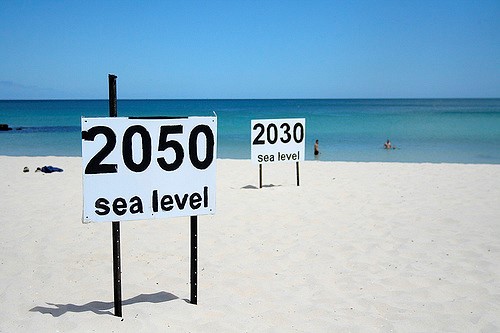Pathways into the unknown: Can your community cope with rising tides?

As Texas recovers from the force of Hurricane Harvey and the Caribbean assesses its losses from Hurricane Irma, it is time for coastal communities to reflect on what makes a resilient community in the face of more frequent storm events, rising sea levels and changing coastal flooding patterns. How would you be affected? Would we fare any better in Australia?
Last year, many Australians experienced the power of the sea with coastal storms battering houses along the east coast of Australia, whilst destroying jetties and smashing beaches in South Australia. Additionally, another sort of flooding is emerging abroad – nuisance flooding – that is increasingly causing disruption to people and infrastructure in cities like Annapolis and Miami Beach.
Rising sea levels and changing coastal flood patterns will place increasing pressure on governments, business and residents to minimise impacts to people, properties and the environment. As Australia debates national energy reform and seeks to meet their emissions targets under the Paris Agreement, it is imperative that planning continues for sea level rise, which will continue regardless of future emissions stabilisation.
Preparing communities for sea level rise and increased coastal flooding is a difficult task. Scientists know that change is underway, but exactly how much will come our way is uncertain. Do coastal authorities prepare for a sea-level rise of 20 centimetres or half a metre? What population change will occur? The extent and timing of such change may be uncertain, but that doesn’t mean communities can’t start planning for it now.
The legacy of existing infrastructure
Billions of dollars of infrastructure in Australia could be threatened by rising sea levels at the end of the century. Although such timeframes appear distant, planning and development decisions made today can have consequences many years from now.
Coastal infrastructure such as roads, utilities, rail, residential and commercial buildings often last between 20-100 years and influence future developments within communities.
Over the coming decades, existing coastal infrastructure in vulnerable communities will be tested as sea level rise drives more frequent inundation and erosion events. This can cause direct and indirect losses to coastal residents, business and government.
How will rising sea levels affect you?
Climate change will not only affect our infrastructure, it will affect our beaches, and our access to other coastal environments; it will have real impacts on where we recreate and socialise.
To better understand what aspects of people’s everyday lives are important, where certain values are associated with coastal landscapes, and what groups of people might be most disadvantaged by sea level rise, we undertook a study in a peri-urban seaside suburb in Tasmania.
We found that overall, the natural environment and the lifestyle that it affords was most important to residents. Such values were consistent with those identified in other south-eastern Australian studies.
Our study then segmented the seaside community into six groups based upon their life stage, lifestyles and unique social values. This allowed us to understand how people in the community might be affected differently from sea level rise.
We found that whilst the local beach was highly important for recreational value to families and active younger residents, for others (e.g. community-minded volunteers or retirees) manmade features such as community halls and ovals were likely to be of greater importance as they facilitate important social interactions for these people – considerations that are commonly not well accounted for in traditional risk assessments and planning.
Our work suggests that segmenting the community into groups to support adaptation planning can help to cater for the needs of everyone in the community. It can also improve the fairness of adaptation plans by better assigning the costs and benefits of adaptation, both socially and economically.
How does a resilient coastal community adapt?
Local knowledge about the social as well as physical impacts of sea level rise can help design coastal adaptation plans.
In an earlier study, by comparing characteristics of current adaptation practice in Australia with two state-of-the-art methods from abroad we identified four key principles to improve long-term planning in the face of uncertain coastal change:
- Explore the future with hundreds to thousands of scenarios: Scenarios answer ‘what-if’ questions and support learning in an uncertain world. Each scenario reflects a different combination of sea level rise, population change and other uncertain variables. Assessing physical impacts across many scenarios means a greater uncertainty ‘space’ can be explored to identify vulnerabilities within communities.
- Know ‘what’ change can be accommodated: Assessing the impacts across many scenarios helps understand what environmental change will cause unacceptable impacts to people, properties and the environment. This allows ‘tipping points’ to be identified that helps understand when adaptation responses are needed.
- Develop plans that are flexible: Planning flexible adaptation strategies allows communities to focus on near-term actions, whilst keeping future options open in the face of uncertainty. As more information becomes available, communities can decide an appropriate adaptation response.
- Favour robust adaptation responses across multi-decadal timeframes: Robust adaptation responses perform adequately across many different future scenarios. This is in contrast to optimal adaptation responses which maximise adaptation benefits based upon future assumptions. When adaptation responses are designed to last for many decades, optimisation methods can be risky as the future is likely to deviate from assumptions.
With recent funding cuts to the National Climate Change Adaptation Research Facility in Australia – responsible for the decision-support tool CoastAdapt – communities and business will have an increasing role to play in maintaining the momentum behind adaptation action. It’s time to start thinking about how rising sea levels might affect you and your community, and what your local council is doing to prepare for the future.
Note: This article is based upon “A review of methodologies applied in Australian practice to evaluate long-term coastal adaptation options”, Climate Risk Management, June 2017, and “Advancing values-based approaches to climate change adaptation: A case study from Australia”, Environmental Science and Policy, July 2017.
